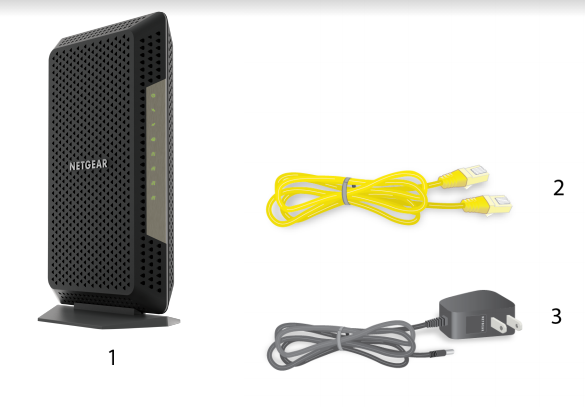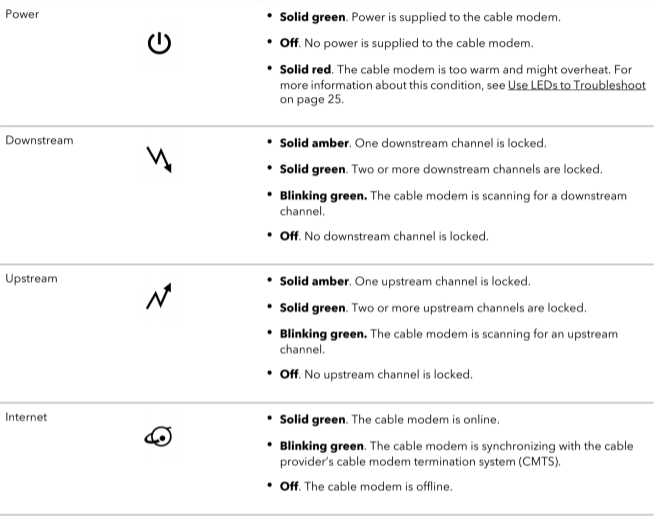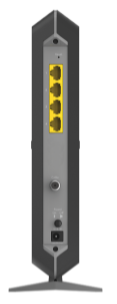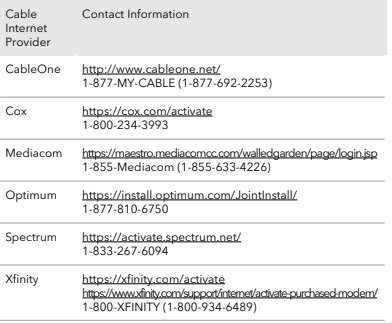Support
Thank you for purchasing this NETGEAR product.
You can visit https://www.netgear.com/support/ to register your product, get help, access the latest downloads and user manuals, and join our community. We recommend that you use only official NETGEAR support resources.
Contact your Internet service provider for technical support.
Trademarks
©NETGEAR, Inc. NETGEAR and the NETGEAR Logo are trademarks of NETGEAR, Inc. Any non-NETGEAR trademarks are used for reference purposes only.
Compliance and Conformity
Forregulatory compliance information, visit https://www.netgear.com/about/regulatory/. See the regulatory compliance document before connecting the power supply.
Note to CATV system Installer- This reminder is provided to call the CATV systems installer’s attention to Section 820-93 of the National Electrical Code which provide guidelines for proper grounding and in particular, specify that Coaxial cable shield shall connected to the grounding system of the building, as close to the point of cable entry as practical
Hardware Setup
Unpack Your Cable Modem
Your package contains the following items.

- High Speed Cable Modem
- Ethernet cable
- Power adapter
Front Panel and LEDs
The cable modem provides status LEDs on the front.

You can use the LEDs to verify status and connections. The following table lists and describes each LED on the cable modem.



Rear Panel
The connections and button on the rear panel are shown in the following figure.

Viewed from top to bottom, the back panel contains the following components:
• Reset button. Pressing the Reset button resets the cable modem. If the Reset button is pressed for at least seven seconds, the Power LED blinks green and the cable modem returns to its factory settings.
• LAN ports. For installation and activation, connect a computer to the LAN 1 port. After you install the cable modem and activate your Internet service, you can disconnect the computer and connect a router to this port. You can use the LAN 2 port to set up Ethernet port aggregation. For more information, see Ethernet Port Aggregation on page 19.
• Coaxial cable port. Connect the cable port to a cable wall outlet.
• Power On/Off button. Press the Power On/Off button to provide power to the cable modem.
• DC power connector. Connect the power adapterthat came in the product package to the DC power connector.
Label
The cable modem label shows the login information, MAC address, and serial number.

System Requirements
You need the following to install your cable modem:
• Compatible operating system:
- Windows 10
- Windows 8
- Windows 7
- Windows Vista
- Windows XP
- Windows 2000
- Mac OS
- Other operating systems running a TCP/IP network
• Compatible web browser: - Microsoft Internet Explorer 5.0 or later
- Firefox 2.0 or later
- Safari 1.4 or later
- Google Chrome 11.0 or later
• Cable broadband Internet service
Install and Activate Your Cable Modem
The cable modem provides a connection between your cable Internet provider’s network and your computer, router, or WiFi router.
Connect Your Cable Modem to a Computer
After you install the cable modem and activate yourInternet service, you can disconnect the computer and connect a router to the cable modem.

To connect your cable modem directly to a computer:
- Turn off and disconnect existing modems and routers. If you are replacing a modem that is currently connected in your home, unplug the modem and plug the new cable modem into the same outlet.
- Connect a coaxial cable. Use a coaxial cable to connect the cable port on the cable modem to a cable wall outlet. Make sure that the cable is tightly connected.
- Connect the power adapter to the cable modem and plug the power adapter into an electrical outlet. When the startup is complete, the Power LED lights green. If the Power LED does not light, press the Power On/Off button.
- Wait for the cable modem to come online. The cable modem comes online when the Internet LED stops blinking and lights
solid green. This process might take up to 10 minutes. - Connect a computer to the cable modem. Use the Ethernet cable that is provided in the package to connect a computer to the Ethernet port on the cable modem.
Note: Your cable modem comes with a plug that covers the LAN 2, 3, and 4 ports. You can remove the plug to connect a router that supports Ethernet port aggregation. For more information, see the cable modem’s user manual.
- Reboot the computer.
- Activate your Internet service.
Note: After you install and activate the cable modem, you can disconnect the computer and connect a router to the cable modem.
Activate Your Internet Service
Before you activate your Internet service, gather the following information:
• Your cable Internet provider account information
• Cable modem model number, which is CM1200
• Cable modem serial number, which is on the cable modem label
• Cable modem MAC address, which is on the cable modem label

The following is contact information for cable Internet providers that support your cable modem.

Note: Your cable Internet provider’s contact information might change. You can find the contact information in your monthly Internet service billing statement.
To activate your Internet service:
- Visit your cable Internet provider’s website and follow the onscreen instructions to activate your Internet service.
- If you are unable to activate your Internet service using the instructions on your cable Internet provider’s website, call your cable Internet provider for support.
- To determine the accurate Internet speed, visit your cable Internet provider’s speed test website and perform a speed test. If your actual speed is lower than your subscribed speed, contact your cable Internet provider.
Perform a Speed Test
To determine the accurate Internet speed, visit the speed test website of your cable Internet provider and perform a speed test.
If your actual speed is lower than your subscribed speed, contact your cable Internet provider.
Connect Your Cable Modem to a Router After Installation and Activation
After you install the cable modem and activate your Internet service, you can disconnect the computer and connect a router to the cable modem.

To connect your cable modem to a router after installation and activation:
- Reboot the cable modem by unplugging the power cable from the cable modem and plugging it back in. Wait for the Internet LED to stop blinking and light solid green.
- Use an Ethernet cable to connect the Ethernet port on the cable modem to the WAN or Internet port on the router.
- Power on the router.
- Wait until the router is ready.
- Connect a computer to the router.
For more information about how to set up your router, see the documentation that came with your router.
Manage Your Network
After you set up the cable modem, you do not need to log in to the cable modem for normal operation. However, you can log in to the cable modem to change a very limited number of settings and monitor the cable modem.
Log In to the Cable Modem
To log in to the cable modem:
- Connect a computer to your cable modem.
You can connect a computer to your cable modem using the following methods:
• Connect a computer to your cable modem using an Ethernet connection.
• Connect a WiFi router to your cable modem using an Ethernet connection, and then connect a computer to your router using a WiFi or Ethernet connection. - Launch a web browser.
- Enter http://192.168.100.1. A login window opens.
- Enter the admin user name and password.
The user name is admin. The default password is password. The user name and password are case-sensitive.
The BASIC Home page displays.
Change the admin Password
You can change the default password that is used to log in to the cable modem with the admin user name.
Note: Be sure to change the password for the user name admin to a secure password. The ideal password contains no dictionary words from any language and contains uppercase and lowercase letters, numbers, and symbols. It can be up to 30 characters.
To set the password for the user name admin:
- Launch a web browser from a computer that is connected to your cable modem.
- Enter or http://192.168.100.1.
A login window opens. - Enter the admin user name and password.
The user name is admin. The default password is password. The user name and password are case-sensitive.
The BASIC Home page displays.
- Select ADVANCED > Administration > Set Password.
The Set Password page displays. - Type the old password, and type the new password twice.
- Click the Apply button.
Your settings are saved.
View Cable Modem Initialization
You can track the initialization procedure of the cable modem and get details about the downstream and upstream cable channel. The time is displayed after the cable modem is initialized.
The cable modem automatically goes through the following steps in the provisioning process:
- Scans and locks the downstream frequency and then ranges the upstream channels.
- Obtains a WAN address for the cable modem.
- Connects to the Internet.
To view the status of the cable modem initialization:
- Launch a web browser from a computer that is connected to your cable modem.
- Enter http://192.168.100.1.
A login window opens. - Enter the admin user name and password.
The user name is admin. The default password is password. The user name and password are case-sensitive.
The BASIC Home page displays. - Select Cable Connection.
The Cable Connection page displays.
The Startup Procedure section displays the initialization progress. The page also displays the status of all downstream and upstream channels. (You must scroll down to view all the channels.) The number of downstream and upstream channels that are locked depends on the number of channels that your Internet provider uses.
View Cable Modem Status
To view cable modem status and usage information:
- Launch a web browser from a computer that is connected to your cable modem.
- Enter http://192.168.100.1.
A login window opens. - Enter the admin user name and password.
The user name is admin. The default password is password. The user name and password are case-sensitive.
The BASIC Home page displays. - Click the ADVANCED tab.
The ADVANCED Home page displays information about your cable modem.
View and Clear Event Logs
Event logs capture important cable modem events.
To view and clear the event logs:
- Launch a web browser from a computer that is connected to your cable modem.
- Enter http://192.168.100.1.
A login window opens. - Enter the admin user name and password.
The user name is admin. The default password is password. The user name and password are case-sensitive.
The BASIC Home page displays. - Select ADVANCED > Administration > Event Log.
The Event Log page displays the following information:
• Time. The time the event was recorded.
• Priority. The severity for this event.
• Description. A description of this event. - To refresh the page, click the Refresh button.
- To clear the log entries, click the Clear Log button.
Specify the Cable Connection Starting Frequency
The starting frequency is automatically generated. For most Internet connections, you do not need to specify this information. If you must enter a starting frequency, contact your Internet provider.
To change the starting frequency:
- Launch a web browser from a computer that is connected to your cable modem.
- Enter http://192.168.100.1.
A login window opens. - Enter the admin user name and password.
The user name is admin. The default password is password. The user name and password are case-sensitive.
The BASIC Home page displays. - Select Cable Connection.
The Cable Connection page displays the status of all downstream and upstream channels. - In the Starting Frequency field, type a number as instructed by your cable Internet provider.
- Click the Apply button.
Your settings are saved.
Ethernet Port Aggregation
Ethernet aggregation lets you use the LAN 1 and 2 ports on your cable modem to improve the aggregated transfer speed. Note that Ethernet port aggregation is also referred to as link aggregation, teaming port, and port trunking. If a router or computer supports Ethernet aggregation, you can connect your router or computer to the LAN 1 and 2 ports on your cable modem.
To set up Ethernet port aggregation with your cable modem, you need the following:
• A service provider that offers an Internet speed that’s over 1 Gbps.
• A router or computer that supports the following:
- 802.3ad LACP
- Ethernet port aggregation on its WAN ports
Warning: To avoid causing broadcast looping, which can shut down your network, do not connect an unmanaged switch to the LAN 1 and 2 port on your cable modem.
Set Up Ethernet Port Aggregation
To set up Ethernet port aggregation:
- Configure your router or computer before connecting it to the cable modem. For information about how to set up Ethernet port aggregation on your router or computer, see the documentation that came with your router or computer.
- Connect the Ethernet ports on your router or computer that support Ethernet port aggregation to the LAN 1 and 2 ports on your cable modem.
View the Ethernet Port Aggregation Status
To view your cable modem’s Ethernet port aggregation status:
- Launch a web browser from a computer that is connected to your cable modem.
- Enter http://192.168.100.1.
A login window opens. - Enter the admin user name and password.
The user name is admin. The default password is password. The user name and password are case-sensitive.
The BASIC Home page displays. - Select ADVANCED > Advanced Setup > Ethernet Port Aggregation.
The Ethernet Port Aggregation page displays the Ethernet port aggregation status on the page.
Change the Ethernet Port Aggregation Configuration Mode
To change your cable modem’s Ethernet port aggregation configuration mode:
- Launch a web browser from a computer that is connected to your cable modem.
- Enter http://192.168.100.1.
A login window opens. - Enter the admin user name and password.
The user name is admin. The default password is password. The user name and password are case-sensitive.
The BASIC Home page displays. - Select ADVANCED > Advanced Setup > Ethernet Port Aggregation.
The Ethernet Port Aggregation page displays. - Select a configuration mode:
• Disable. This is the default mode. This mode disables the Ethernet port aggregation function on the cable modem. Do not use the LAN 2 port if you select this mode.
• Enable (LACP-IEEE 803.3ad). The cable modem communicates with the router or computer that is connected to the LAN 2 port on your cable modem and checks to see if Ethernet port aggregation is supported on the router or computer. If Ethernet port aggregation is supported, the cable modem automatically trunks the LAN 2 port. If not, the LAN 2 port will not pass traffic.
Reboot the Cable Modem
Rebooting the cable modem disconnects all network connections to the cable modem’s local area network (LAN). After the cable modem is finished booting and reestablishes a connection with the Internet, the devices on your network reconnect to the cable modem’s LAN.
To reboot the cable modem:
- Launch a web browser from a computer that is connected to your cable modem.
- Enter http://192.168.100.1.
A login window opens. - Enter the admin user name and password.
The user name is admin. The default password is password. The user name and password are case-sensitive.
The BASIC Home page displays.
- Click the ADVANCED tab.
The ADVANCED Home page displays. - Click the Reboot button.
A confirmation message displays. - Click the OK button.
The cable modem reboots.
Reset the Cable Modem to Factory Default Settings
To reset the cable modem to factory default settings, you can use either the Reset button on the back panel of the cable modem or the Factory reset software button. However, if you changed the default password that you use to access the cable modem and lost the password, you must use the Reset button on the back panel.
After you reset the cable modem to factory default settings, the password is password. The LAN IP address is always 192.168.100.1. You cannot change this LAN IP address.
Use the Reset Button on the Back Panel
Caution: This process erases all settings that you configured in the cable modem.
To reset the cable modem to factory default settings using the Reset button:
- On the back of the cable modem, locate the Reset button.
- Using a straightened paper clip, press and hold the Reset button until the cable modem reboots itself.
The configuration is reset to factory default settings. This process takes about one minute.
Use the Factory Reset Software Button
Caution: This process erases all settings that you configured in the cable modem.
To reset the cable modem to factory default settings using the Factory reset software button:
- Launch a web browser from a computer that is connected to your cable modem.
- Enter http://192.168.100.1.
A login window opens. - Enter the admin user name and password.
The user name is admin. The default password is password. The user name and password are case-sensitive.
The BASIC Home page displays. - Click the ADVANCED tab.
The ADVANCED Home page displays. - Click the Factory reset button.
A confirmation message displays. - Click the OK button.
The configuration is reset to factory default settings. When the reset is complete, the cable modem reboots. This process takes about one minute.
Warning: To avoid the risk of corrupting the firmware, do not interrupt the reset. For example, do not close the browser, click a link, or load a new page. Do not turn off the cable modem.
Troubleshooting
This chapter provides information about troubleshooting your cable modem. The chapter includes the following sections:
• Use LEDs to Troubleshoot
• Cannot Log In to the Cable Modem
• Troubleshoot the Cable Internet Connection
Use LEDs to Troubleshoot
| LED Behavior | Action |
| All LEDs are off when the cable modem is plugged in. | • Make sure that the power adapter is securely connected to your cable modem and a functioning power outlet. • Check that you are using the 12 VDC, 1.5 A power adapter from NETGEAR for this product. • If the error persists, a hardware problem occurred. Contact technical support. |
| All LEDs stay on. | • Reset the configuration of the cable modem to its factory defaults. • If the error persists, a hardware problem occurred. Contact technical support |
| The Ethernet LED is off for a port with an Ethernet connection. | • Make sure that the Ethernet cable connections are secure at the cable modem and at the computer, router, or WiFi router. • Make sure that power is turned on to the connected hub or computer. • Be sure that you are using the correct cable. |
| The Internet LED is off and the cable modem is connected to the cable wall jack. | • Make sure that the coaxial cable connections are secure at the cable modem and at the wall jack. • Make sure that your Internet service provider provisioned your cable Internet service. Your ISP can verify that the signal quality is good enough for cable modem service. • Remove any excessive splitters that you installed on your cable line. Run a “home run” back to the point where the cable enters your home. |
| The Power LED lights red. | The cable modem is too warm and might overheat. Do the following: 1. Disconnect the power adapter. 2. Wait a couple of minutes to let the cable modem cool down. 3. Make sure that the cable modem is placed in a vertical position. 4. Make sure that the cable modem is placed in a location with good ventilation. 5. Reconnect the power adapter. |
Cannot Log In to the Cable Modem
If you cannot access your cable modem from a computer that is connected to your cable modem or to a router that is connected your cable modem, check the following:
• If your computer is connected to your cable modem with an Ethernet cable, check the connection.
• Make sure that Java, JavaScript, or ActiveX is enabled in your browser. If you are using Internet Explorer, click the Refresh button to make sure that the Java applet is loaded.
• Try quitting the browser and launching it again.
• Make sure that you are using the correct login information. Your cable modem user name admin is lowercase (Caps Lock is off).
• Make sure that your computer’s IP address is on the same subnet as the cable modem. The IP address of your computer must be in the range of 192.168.100.2 to 192.168.100.254.
If your cable modem does not save changes you made, do the following:
• When entering configuration settings, be sure to click the Apply button before moving to another page, or your changes are lost.
• Click the Refresh or Reload button in the web browser. It is possible that the changes occurred, but the web browser is caching the old configuration.
Troubleshoot the Cable Internet Connection
If your cable modem cannot access the Internet but the Internet LED lights green, make sure that the cable MAC address or device MAC address of your cable modem is registered with Internet service provider.
Supplemental Information
This appendix covers the following topics:
• Factory Settings
• Technical Specifications
Factory Settings
The following table shows the factory default settings for the cable modem.
| Feature | Default Setting | |
| Cable modem login | User login URL User name (case-sensitive) Login password (case-sensitive) | http://192.168.100. Admin password |
| Internet connection | Cable modem MAC address Port speed Ethernet port aggregation | Use default hardware address AutoSensing Disabled by default |
Technical Specifications
The following table lists the technical specifications for the cable modem.
| Feature | Specification |
| Power adapter | • Input: 110–120V, 47–60 Hz • Output: 12 VDC, 1.5 A |
| Physical specifications | • Dimensions: 6.1 x 3.4 x 10.3 in. (155 x 87 x 261 mm) • Weight: 1.22 lb (553 g) |
| Environmental | • Operating temperature: 32° to 104°F (0° to 40°C) • Operating humidity: 90% maximum relative humidity, noncondensing |
| Interface | • Local: Four 10/100/1000 RJ-45 Gigabit Ethernet ports • Internet: Coaxial cable connector DOCSIS 3.1; backward-compatible with DOCSIS 3.0 |
| Channels | • 2 OFDM and 32 SC-QAM bonded downstream • 2 OFDMA and 8 SC-QAM bonded upstream |
| Certifications | FCC/UL |
You can download the PDF version of the NETGEAR Nighthawk Multi-Gig Speed Cable Modem Model CM1200 User Manual here.